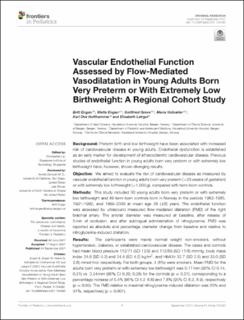| dc.description.abstract | Background: Preterm birth and low birthweight have been associated with increased risk of cardiovascular disease in young adults. Endothelial dysfunction is established as an early marker for development of atherosclerotic cardiovascular disease. Previous studies of endothelial function in young adults born very preterm or with extremely low birthweight have, however, shown diverging results.
Objective: We aimed to evaluate the risk of cardiovascular disease as measured by vascular endothelial function in young adults born very preterm (<29 weeks of gestation) or with extremely low birthweight (<1,000 g), compared with term-born controls.
Methods: This study included 50 young adults born very preterm or with extremely low birthweight and 49 term-born controls born in Norway in the periods 1982–1985, 1991–1992, and 1999–2000 at mean age 28 (±6) years. The endothelial function was assessed by ultrasound measured flow-mediated dilatation (FMD) of the right brachial artery. The arterial diameter was measured at baseline, after release of 5 min of occlusion, and after sublingual administration of nitroglycerine. FMD was reported as absolute and percentage diameter change from baseline and relative to nitroglycerine-induced dilatation.
Results: The participants were mainly normal weight non-smokers, without hypertension, diabetes, or established cardiovascular disease. The cases and controls had mean blood pressure 112/71 (SD 12/9) and 112/69 (SD 11/8) mmHg, body mass index 24.0 (SD 4.2) and 24.4 (SD 4.5) kg/m2, and HbA1c 32.7 (SD 2.5) and 33.0 (SD 2.6) mmol/mol, respectively. For both groups, 4 (8%) were smokers. Mean FMD for the adults born very preterm or with extremely low birthweight was 0.17 mm (95% CI 0.14, 0.21) vs. 0.24 mm (95% CI 0.20, 0.28) for the controls (p = 0.01), corresponding to a percentage increase of 5.4% (95% CI 4.2, 6.6) and 7.6% (95% CI 6.2, 8.9), respectively (p = 0.02). The FMD relative to maximal nitroglycerine-induced dilatation was 20% and 31%, respectively (p = 0.001).
Conclusions: Young adults born very preterm or with extremely low birthweight have significantly lower FMD compared with the term-born controls suggesting an increased risk of cardiovascular disease. | en_US |

